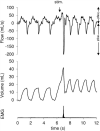Impact of Inhaled Corticosteroids on the Modulation of Respiratory Defensive Reflexes During Artificial Limb Exercise in Ovalbumin-Sensitized Rabbits
- PMID: 35145425
- PMCID: PMC8821955
- DOI: 10.3389/fphys.2021.804577
Impact of Inhaled Corticosteroids on the Modulation of Respiratory Defensive Reflexes During Artificial Limb Exercise in Ovalbumin-Sensitized Rabbits
Abstract
Introduction: Cough is a major lower airway defense mechanism that can be triggered by exercise in asthma patients. Studies on cough reflex in experimental animal models revealed a decrease of cough reflex sensitivity during exercise in healthy animals, but a lack of desensitization in ovalbumin-sensitized rabbits. The aim of our study is to evaluate the impact of inhaled corticosteroids on cough reflex during artificial limb exercise in an animal model of eosinophilic airway inflammation.
Materials and methods: Sixteen adult ovalbumin-sensitized rabbits were randomly divided into two groups. The "OVA-Corticoid" group (n = 8) received inhaled corticosteroids (budesonide; 1 mg/day during 2 consecutive days) while the "OVA-Control" (n = 8) group was exposed to saline nebulization. The sensitivity of defensive reflexes induced by direct mechanical stimulation of the trachea was studied in anesthetized animals, at rest and during artificial limb exercise. Cell count was performed on bronchoalveolar lavage fluid and middle lobe tissue sections to assess the level of eosinophilic inflammation.
Results: All rabbits were significantly sensitized but there was no difference in eosinophilic inflammation on bronchoalveolar lavage or tissue sections between the two groups. Artificial limb exercise resulted in a significant (p = 0.002) increase in minute ventilation by 30% (+ 209 mL.min-1, ± 102 mL/min-1), with no difference between the two groups. 322 mechanical tracheal stimulations were performed, 131 during exercise (40.7%) and 191 at rest (59.3%). Cough reflex was the main response encountered (46.9%), with a significant increase in cough reflex threshold during artificial limb exercise in the "OVA-Corticoid" group (p = 0.039). Cough reflex threshold remained unchanged in the "OVA-Control" group (p = 0.109).
Conclusion: Inhaled corticosteroids are able to restore desensitization of the cough reflex during artificial limb exercise in an animal model of airway eosinophilic inflammation. Airway inflammation thus appears to be involved in the physiopathology of exercise-induced cough in this ovalbumin sensitized rabbit model. Inhaled anti-inflammatory treatments could have potential benefit for the management of exercise-induced cough in asthma patients.
Keywords: asthma; corticosteroids (CS); cough; defensive reflex; exercise.
Copyright © 2022 Basin, Valentin, Demoulin-Alexikova, Demoulin, Foucaud, Gérard, Pouget, Allado, Chenuel and Poussel.
Conflict of interest statement
The authors declare that the research was conducted in the absence of any commercial or financial relationships that could be construed as a potential conflict of interest.
Figures


References
LinkOut - more resources
Full Text Sources
Miscellaneous

